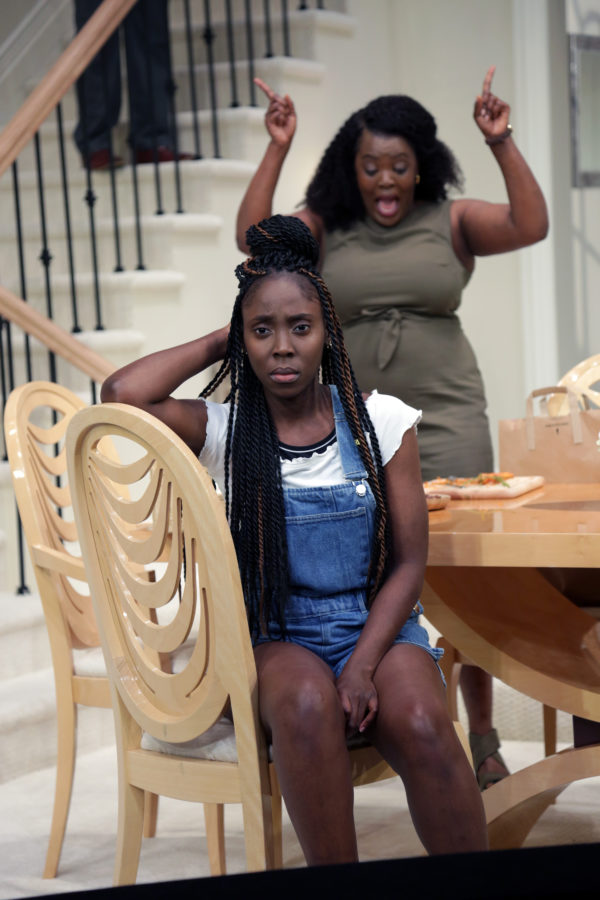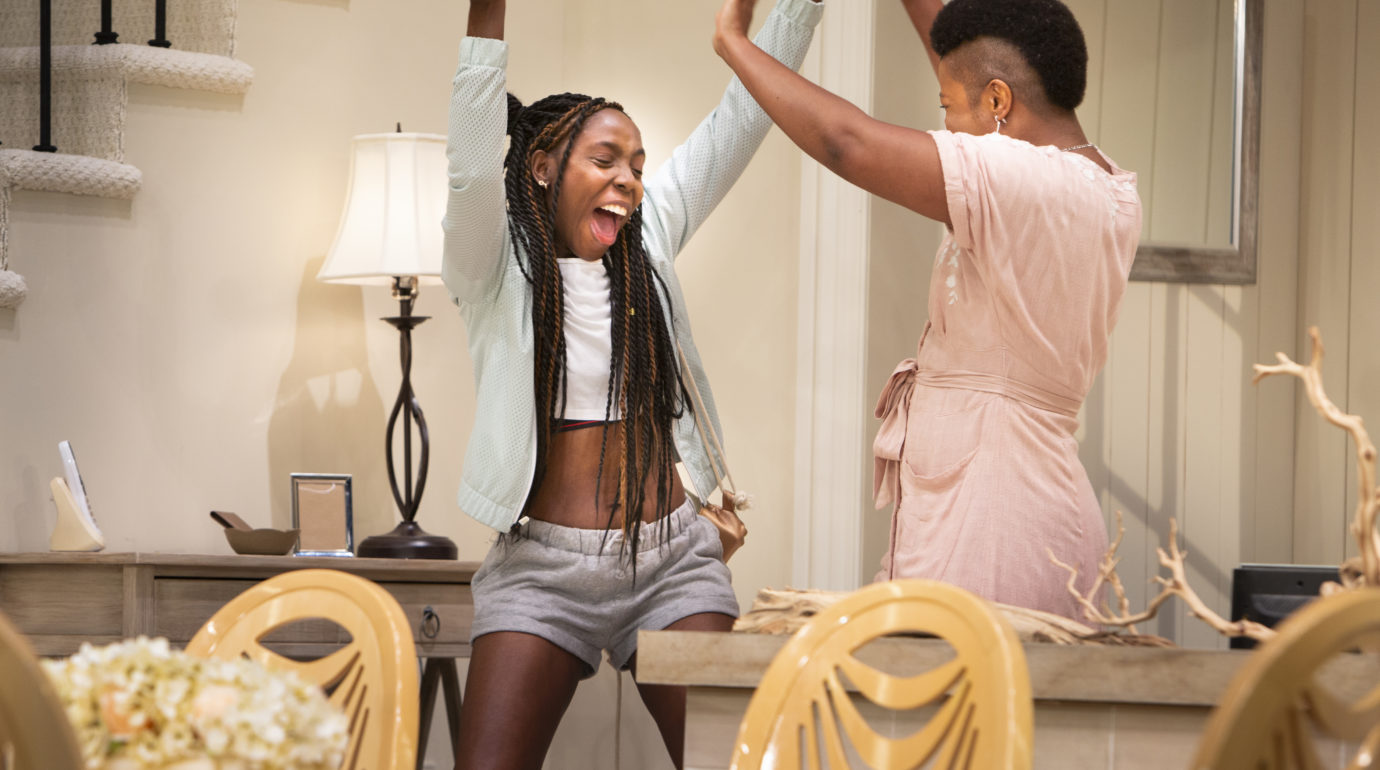This essay contains spoilers for Fairview by Jackie Sibblies Drury, currently running through August 11 at the Polonsky Shakespeare Center.
I recently saw Jackie Sibblies Drury’s Pulitzer-winning play Fairview with my mother. Like Drury, whose parents are from Jamaica, my parents also come from the Caribbean—Trinidad and St. Vincent, specifically. There they were not minorities; their brown skin was the default. It was upon their arrival in this country that they first tasted the bitterness of racial discrimination.
While the stories of many first-generation daughters are wrought with hardship, my life has always felt like a comparatively easy one—a tangible result of my parents’ hard work and my middle-class upbringing. Like Drury’s, my interest in theatre was encouraged with Christmas gifts of cast albums and tickets to Broadway shows, even though there are no artists in my nuclear family. When Drury spoke with American Theatre a few months back, she mentioned long car rides with her mother set to the soundtrack of Phantom of the Opera; in my family, the soundtrack was Les Miz.
So I felt a kinship to Drury; we are both Black women with families from the Caribbean raised with a certain level of comfort. Our existence poses a direct contrast to the struggles of many Black families seen on television and in film and theatre: the Youngers, the Maxons, the Browns, every one of Ntozake Shange’s colored girls. Growing up Black and financially free is not uncommon, but it is in direct contrast to what we are told by the white dominant culture that we can be.
Though I grew up comfortable, having money didn’t save me from discrimination. I have been called derogatory names on the street, followed in stores, pulled over by a wannabe cop—things all Black folks face in this country regardless of their tax bracket. I imagine the same is true of Drury.
With this arsenal of assumptions about her life and its similarities to mine, I walked into Theatre for a New Audience’s stunning Polonsky Shakespeare Center, expecting Fairview to feel familiar too. But none of that personal affinity prepared me for the radicalism of Drury’s play.
At the top of Fairview we meet a few members of the Frasier family (all Black, beautiful, and well-off) as they gear up for Grandma’s birthday. The preparations involve obsessive cooking, cleaning, and organizing, since one of Grandma’s daughters, Beverly, is insistent that the night goes well. Everything has to be top-notch for company—she even swaps her Nikes for chic sandals to assure it. Her neurotic desire to please immediately sets the stakes for this celebration, which feels doomed before it’s even begun.
The experimentalism of Fairview begins in Act Two, when audience members find out that they are not the only ones tuned in to watch the Frasiers. As Act One replays itself, we hear that an increasingly loud cohort of offstage voices is in on the action too. The apparently all-white voices begin by mulling a question: ”If you could choose, what race would you be?” Blatantly ignorant answers ensue, including the following words from Jimbo, the loudest voice of them all: “I wouldn’t want to be a rich Black person. You know? It wouldn’t be…very authentic. I’m just thinking critically about it and, don’t you think that once a person has enough money, their race just kind of disappears and they’re just rich? Like, if I’m going to be Black, I’d want to be a normal Black person.”
The resounding answer to the “doesn’t race disappear” question is “no.” As previously mentioned, no amount of wealth can completely erase the consequences of Black skin. Unbelievably, the rest of the white characters are just as brazen with their assumptions. Then they go as far as to appear onstage and physically insert themselves into the Frasier family’s story, though not before rewriting it: The teenage Keisha becomes pregnant, father Dayton has lost the family’s house due to gambling debts, and Beverly is on crack—all routine stereotypes.
Keisha, played by the luminous MaYaa Boateng, is the only one to stop the action and question why her story is being examined, manipulated, and controlled in this way. She turns to a member of the white cohort and says, “Stop. Please, stop. I know what you’re going to say because…Because you have told me every story I have ever heard. And I…I need you to listen.”
It is true that many notable narratives about Black people were created and are maintained by white entertainment industry stakeholders. We see this with films like The Help and Green Book, and theatrical works like To Kill a Mockingbird. Black people may decry them as disingenuous, offensive, and harmful, but they wind up earning millions of dollars at the box office, Academy Awards, and sometimes even a sequel.
Though I am not sold on the argument that white people are 100 percent incapable of supporting non-white narratives (Fairview is in fact directed by a white woman, Sarah Benson), I hate that they have gotten so many more opportunities than we have to try. If white people are still the primary purveyors of our stories, if they are still the production managers, dramaturgs, critics, artistic and executive directors, then how much of what we accept as Black culture onstage is actually true, and how much is tainted? Are efforts to “diversify theatre” really about serving us, or are they intended to pay lip service? If people of color were able to speak freely to other people of color in a theatrical space, what would we say?

In the final moments of the play, Keisha tries to address the latter question but admits, “It’s difficult because I’ve already heard so many stories. It’s hard to find the one I’d wanted to tell.”
Hopefully Keisha would be proud of the glorious array of POC-authored work produced on New York stages this season. But like me, I bet she would also fear that too many theatres think programming these plays is sufficient action. It is not. If there are no steps taken toward embracing underrepresented communities and making them a priority in the space, then the work is futile, even exploitative.
And it gives white theatregoers permission to think of their ticket purchase as a supportive action in itself. Again: It is not. If it were, then young patrons of color would not be treated as a nuisance, shushed, told to laugh less, or made to feel like we don’t belong in the theatre. Our presence would be the status quo and we could fully claim the theatre as a place of expression, representation, and reflection.
If you have read anything about Fairview, you likely know that its final moments are particularly engaging. In an effort to not give anything away, I’ll say that if the first three quarters of Drury’s masterpiece cause white audience members to feel embarrassed or guilty, the last quarter gives them a chance to do something about it. In The Light of the Truth, Ida B. Wells writes, “The way to right wrongs is to turn the light of truth upon them.” This is exactly what watching Fairview felt like: a reckoning disguised as recognition. This is theatre in its highest form. An easier play may have intended for shame to be the only thing white people walk away with, but Fairview calls on them to act on it.
Brittani Samuel is a writer currently based in New York. For her thoughts on all things art, culture, entertainment and/or Rihanna, check out her blog. You can find very similar content on her Instagram @brittaniidiannee.


